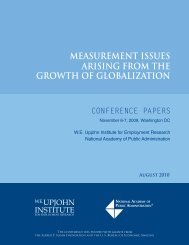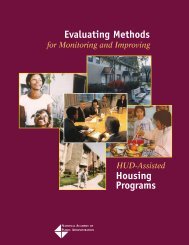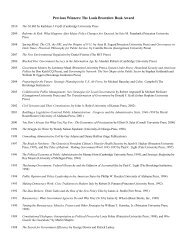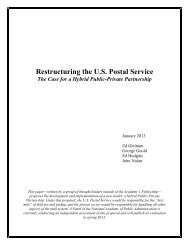High-Performance Partnerships - National Academy of Public ...
High-Performance Partnerships - National Academy of Public ...
High-Performance Partnerships - National Academy of Public ...
You also want an ePaper? Increase the reach of your titles
YUMPU automatically turns print PDFs into web optimized ePapers that Google loves.
RESULTS<br />
chapter four<br />
4. Define results that are important to the<br />
partners, community, and funders.<br />
Most public/nonpr<strong>of</strong>it partnerships are not<br />
blessed with self-sustaining funding sources. It<br />
is imperative that they achieve results important<br />
to funders and the community at large.<br />
Key stakeholders must conclude that their<br />
return on investment warrants the time and<br />
resources devoted to the collaborative effort.<br />
5. Low risk means low success.<br />
The public sector generally is risk adverse, and<br />
for good reason. Government must be a steward<br />
<strong>of</strong> the public’s interests and tax dollars.<br />
However, partnerships that avoid all risk will<br />
not realize their full potential. They must be<br />
willing to take reasonable, informed risks that<br />
are designed to achieve significant results.<br />
Otherwise, their success can only be so great.<br />
If the initiative does not work, partnerships<br />
should be prepared to evaluate what happened,<br />
retool, and try again.<br />
6. Use research on best practices.<br />
<strong>Partnerships</strong> benefit enormously by studying<br />
the successes and failures <strong>of</strong> other communities<br />
that deal with similar concerns. <strong>Public</strong><br />
organizations at every level—federal, regional,<br />
state, and local—provide excellent research on<br />
a wide range <strong>of</strong> public policy issues. Each sector<br />
has organizations that can provide best<br />
practices data for defining appropriate objectives<br />
and outcomes and assisting implementation<br />
strategies. The partnership may use neutral<br />
parties to facilitate the selection <strong>of</strong> measures<br />
and evaluation processes.<br />
In the City <strong>of</strong> Des Moines, debate continues over how<br />
data should be interpreted. If there is an increase in<br />
police calls from a neighborhood, does this mean there is<br />
more crime or greater awareness and reporting due to<br />
an <strong>of</strong>ficer being assigned there? If calls decrease, does<br />
this mean the neighborhood is safer or that calls are<br />
being directed to the NBSD <strong>of</strong>ficer? The likelihood is<br />
that data must be tracked for several years before they<br />
can be meaningfully interpreted.<br />
Neighborhood Based Service Delivery (Des Moines)<br />
AVAILABILITY OF ACCURATE,TIMELY<br />
DATA TO MEASURE RESULTS<br />
The Challenges<br />
Once a partnership identifies its results, it<br />
must adequately measure performance. Yet<br />
securing accurate and timely data can be problematic.<br />
One challenge is the lack <strong>of</strong> sufficient<br />
baseline information to evaluate current conditions.<br />
This frequently causes communities<br />
and organizations to embrace a policy or program<br />
based on anecdotal information. One<br />
example is a partnership that uses juvenile<br />
arrest statistics to measure the reducing juvenile<br />
crime goal. This measure may capture the<br />
police department’s effectiveness in apprehending<br />
criminals, not the true number <strong>of</strong><br />
juvenile crimes. Raw data can be difficult to<br />
interpret without considering the context, so a<br />
partnership must avoid the temptation to<br />
define its objectives based primarily on those<br />
data alone.<br />
Important community outcomes <strong>of</strong>ten are difficult<br />
to quantify, at least on a timely basis.<br />
<strong>High</strong> data gathering costs may cause a partnership<br />
to rely on information collected for general<br />
community purposes, such as the Census.<br />
Unfortunately, definitive results every decade<br />
are not sufficient to evaluate partnership performance<br />
and make midcourse corrections.<br />
For example, Neighborhoods in Bloom identified<br />
increased home ownership as a critical success<br />
measure. Other than decennial census<br />
information, however, homeownership data<br />
were not available on a reliable basis. As a result,<br />
the city’s ability to accurately measure its impact<br />
on ownership rates proved challenging.<br />
Even with quantifiable information, reporting<br />
timelines and formats may be different. The<br />
partnership must be aware <strong>of</strong> the general availability<br />
<strong>of</strong> data, and the partners’ willingness<br />
and ability to record them in a consistent and<br />
timely manner. Complexity further increases<br />
when the data come from different organizational<br />
systems, raising the “my computer doesn’t<br />
talk to your computer” syndrome. When a<br />
partnership’s purpose is human services-related,<br />
confidentiality <strong>of</strong> information can be an<br />
obstacle, as well.<br />
70 Powering the Future: <strong>High</strong>-<strong>Performance</strong> <strong>Partnerships</strong>









